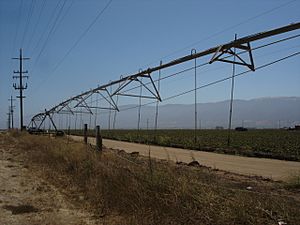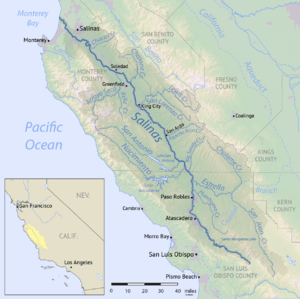Salinas Valley facts for kids
Quick facts for kids Salinas Valley |
|
|---|---|
| Valle de Salinas (Spanish) | |

Salinas Valley, on River Road near Greenfield.
|
|
| Length | 90 miles (145 km) northwest to southeast |
| Geography | |
| Location | California, United States |
| Population centers | Castroville, Salinas, King City, San Ardo |
| Traversed by | U.S. Route 101 |
| Rivers | Salinas River |
The Salinas Valley is a large valley in California, United States. It's one of the most important places for growing food in the state. The valley is west of the San Joaquin Valley and south of San Francisco Bay.
The Salinas River flows through the valley. This river helped create the valley's shape and played a big part in its history. The valley was named by Spanish settlers in the late 1700s. In Spanish, Salina means a salty area, like a salt marsh or a salt lake. The river used to have salty ponds, especially during dry times.
The valley stretches about 90 miles (145 km) from the southeast to the northwest. It starts near San Ardo and is surrounded by mountains. The Santa Lucia Range is on its west side, and the Gabilan Range is on its east side. The valley ends where the Salinas River meets Monterey Bay.
The Salinas Valley is also famous because it's where many stories by the author John Steinbeck take place. His novels East of Eden and Of Mice and Men are set here.
Contents
Exploring the Salinas Valley's Geography
The Salinas Valley is about 90 miles (145 kilometers) long. It stretches from the mouth of the Salinas River near Castroville and Salinas down to King City and San Ardo. The valley is part of a special geological area called the Salinian Block.
Many towns and cities are located in the Salinas Valley. These include Bradley, Castroville, Chualar, Gonzales, Greenfield, Jolon, King City, Salinas, San Ardo, San Lucas, Soledad, and Spreckels. The valley sits between the Gabilan Range to the east and the Santa Lucia Range to the west.
A Look at the Valley's History
Before European settlers arrived, the Salinan people lived in the valley. They were hunter-gatherers and spoke the Salinan language. Their lands likely stretched from the coast to the Salinas Valley.
In the late 1700s, Spanish missions were built in the Salinas Valley. These included Mission San Miguel Arcángel, Mission San Antonio de Padua, and Mission Nuestra Señora de la Soledad. The city of Soledad grew from one of these missions.
The Spanish missionaries brought diseases like smallpox and measles to the native people. Many Salinan people became sick because they had no protection against these new illnesses. Their population greatly decreased. Over time, many of the remaining native people blended with Spanish and Mexican ranching families.
The farming life in the valley during the 1930s inspired many of John Steinbeck's famous stories. These include East of Eden, Tortilla Flat, Of Mice and Men, The Chrysanthemums, and Johnny Bear.
In September 1963, a bus carrying Mexican farm workers crashed with a train near Chualar. This accident led to changes in how farm workers were treated and helped end a program that brought workers from Mexico.
Farming in the Salinas Valley
Farming is the most important part of the Salinas Valley's economy. People often call the Salinas Valley "the Salad Bowl of the World." This is because it produces huge amounts of lettuce, broccoli, peppers, and many other vegetables. The valley's weather and long growing season are also perfect for growing flowers and grapes for wine.
Most of the salad greens eaten in the U.S. come from this area. Strawberries, lettuce, tomatoes, and spinach are the main crops. Other important crops include broccoli, cauliflower, wine grapes, artichokes, and celery.
The Salinas Valley is also a key area for making wine. Three special wine regions, called American Viticultural Areas, are located here: the Arroyo Seco AVA, the Santa Lucia Highlands AVA, and the Monterey AVA.
Even though farming is central, over 100 manufacturing companies also have their homes in Salinas. Some of the biggest employers in the area are Dole Fresh Vegetable, the County of Monterey, and Salinas Valley Memorial Hospital.
Water Resources in the Valley

The farms in the Salinas Valley get their water from underground supplies. These supplies are partly refilled by rain and snow in the surrounding mountains. Two large reservoirs, Nacimiento and San Antonio, store water. They release it to help refill the underground water, control floods, and provide water for farming.
Wells pump this underground water to irrigate about 275,000 acres (1,110 square kilometers) of fruits and vegetables. It also supplies water to the valley's cities. The Salinas River itself often looks dry on the surface. Water only appears during heavy rains or when water is released from the reservoirs upstream.
Because so much water is used near the mouth of the valley, seawater is starting to mix with the fresh underground water. To help with this, the Salinas Valley Water Project is building a special dam near Salinas. This dam will capture more water during wet periods. Also, projects like the Castroville Seawater Intrusion Project and the Salinas Valley Reclamation Project have been using recycled water for farms since 1998. Their goal is to reduce the need for underground water and slow down the seawater from entering.
Salinas Valley Climate
The weather in the Salinas Valley changes from north to south. The northern part of the valley is closer to Monterey Bay and the cool Pacific Ocean. This keeps it cool in summer and mild in winter. The southern part of the valley has bigger temperature changes, meaning hotter summers and colder winters.
In summer, the land heats up, pulling cool, moist air from the ocean into the valley. This often brings fog and low clouds near Monterey Bay, which sometimes spread further down the valley.
The climate is perfect for the many vineyards in the Santa Lucia Highlands. This has made the River Road Wine Trail a popular place for wine tasting.
Local Events and Attractions
The California Rodeo Salinas is a big event in Salinas. Other popular attractions include the California International Airshow, the National Steinbeck Center, and the Steinbeck Festival.
Food Safety and Spinach
In 2007, some spinach from the Salinas Valley was recalled because of a Salmonella discovery. This event led to discussions about making food safety rules stronger.
See also
 In Spanish: Valle del Salinas para niños
In Spanish: Valle del Salinas para niños



